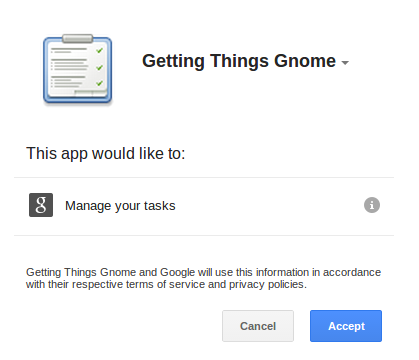Task manager and to-do list online services offer a range of interfaces for the Getting Things Done (GTD) methodology and to unify them under the Getting Things GNOME‘s (GTG) service engine umbrella involved a lot of thought. Google Tasks, Remember the milk (RTM) & Todoist are good choices to be integrated as service plug-ins to GTG as they offer very different implementations.
Authorization


Google Tasks provides standard OAuth 2.0 authorization with only caveat that user needs to copy the authorization code from browser window to GTG (a desktop client) to receive access token & refresh token, else GTG will be required to setup a web server listening to a port to receive authorization code. Also, users behind the firewall will have to grant the incoming port access to GTG for the latter, so it’s much of a hassle for just account authorization which is a one-time deal.
RTM, on the other hand, has OAuth 1.0 authorization, requiring to sign every request, with authorization support for desktop clients such that redirection to a callback URL isn’t required. Todoist simply provides authorization token by username & either password or Google OAuth 2.0 access token (for Log In with Google Account).
Task models
While GTG has no special status for top level tasks, all three services handles the top level tasks as projects/tasklists, as suggested by GTD methodology. Google Tasks provides infinite nesting of tasks using parent ids (just like GTG), Todoist only provides 3 levels of subtasks using indent level, and RTM provides none. To handle these differences, service engine will manage top level tasks of GTG as tasklists to be compatible with online services. Moreover, feature to add notes to a task is paid in Todoist.
Next…
I will implement a local service plug-in to store the GTG’s tasks locally and then move to implementing service engine and synchronization.